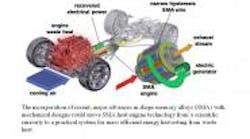“In a hybrid system, the electrical energy could be used to charge the battery. In a conventional engine, this could perhaps even replace the alternator without any load on the engine.” –Jan Aase, director of General Motor’s Vehicle Development Research Laboratory
One of the interesting paths being followed in vehicle research and development these days is how to figure out ways to operate a variety of systems without tapping into the car or truck’s engine.
For example, General Motors is starting work on a prototype system to capture the heat from vehicle engine exhaust and then convert to mechanical energy capable of powering a car or truck stereo, power seats and air conditioning system.
Shape Memory Alloy (SMA) is the critical component here, for generating electricity from the heat in automotive exhaust, explained Jan Aase, director of GM’s Vehicle Development Research Laboratory.
“When you heat up a stretched SMA wire, it shrinks back to its pre-stretched length, and when it cools back down it becomes less stiff and can revert to the original shape,” he said. “A loop of this wire could be used to drive an electric generator to charge a battery. In a conventional engine, this could perhaps even replace the alternator without any load on the engine.”
GM received a $2.7 million federal government grant to help build an SMA prototype, awarded from the Department of Energy’s Advanced Research Program Agency. GM is working with several firms to try and make SMA technology a reality: HRL Laboratories; Dynalloy, Inc., a Tustin, CA manufacturer of shape memory alloys specially made to be used as actuators,;and the Smart Materials Collaborative Research Lab at the University of Michigan.
“The idea of an SMA heat engine has been around for 30 years,” Aase said. “But the few devices that have been built were too large and too inefficient to make it worthwhile. Even now, the technology is in the very early stages, so over the next two years, [we] will work to create a working prototype.”
Toyota offers another example of tapping into external power sources to reduce the engine load on its vehicles – and in its case, this is technology already rolling off the production line.
On its third generation Prius hybrid sedan (the 2010 models), the vehicle’s sliding glass moon-roof is packaged with solar panels, located over the rear seating area, to power a new ventilation system.
Toyota said this solar powered ventilation system helps keep the interior air temperature near the outside ambient temperature when the vehicle is parked directly in the sun, so cool-down time is shorter when the driver returns to the vehicle – thus reducing the use of air conditioning.
[A short video clip about the Prius’ “solar roof” is below, but I warn you – it doesn’t contain much on the technical details of the system.]
Though these technologies are currently in high development gear in the automotive world, they’ve got plenty of potential for the trucking industry.
Take the solar cell concept for starters: I talked with David Kiefer, director of marketing and product management for Carrier Transicold not too long ago and we discussed the possibility of using a similar type of system on refrigeration units in the not-so-distant future.
While Kiefer stressed bringing solar-generated electricity into the reefer – either when connect to solar-equipped buildings or possibly from roof-mounted panels on trailers and truck dry van boxes – is about five years away at the earliest, it holds a lot of promise for fleets operating in parts of the country (think Arizona) where sunshine is abundant and thus the power load on reefers is heavy.
“You couldn’t power the entire hybrid reefer off solar power … but maybe you could get half of the electricity you need from the sun – and that would allow you to reduce the load on the system’s batteries, diesel engine, etc.,” he explained to me.
“Right now, though, solar cells are still not practical – they cost about $3 a cell and you need to get down to around $1 per cell to make it work. Plus there are reliability and durability issues to look at,” Kiefer cautioned. “Yet just five years ago, such cells cost $7 per unit, so the price of the technology is dropping. In another five years, some of these ideas could become reality – but we’re still several years away from this.”
Still, grabbing power little by little from external sources to vehicles – and in comes cases, commercial freight trailers – seems to hold a lot of promise in terms of helping reduce overall fuel consumption as well as individual system power needs.






